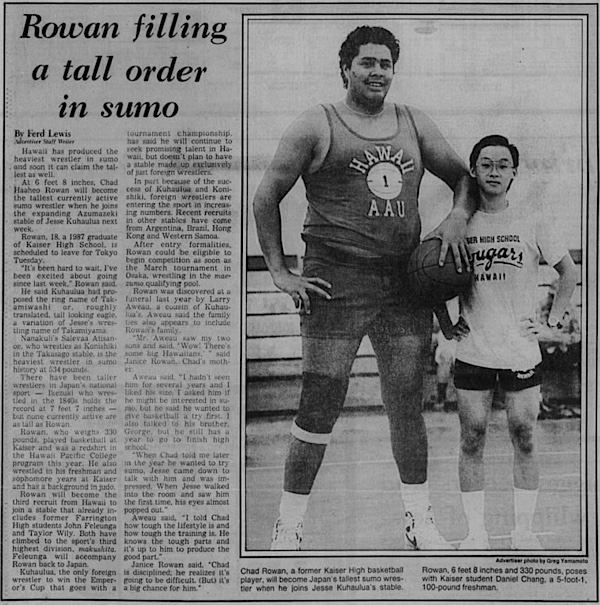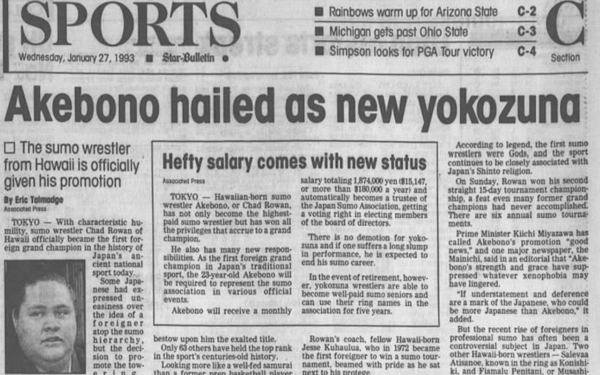By Lance Tominaga, ESPN Honolulu Web Editor.
Standing 6-8 and weighing in at over 500 pounds, it’s easy to say that Hawaii’s Chad Rowan was a larger-than-life champion. As Akebono, Rowan attained international superstar status as the first-ever foreign-born Yokozuna (“Grand Champion”) in Japan’s national sport of sumo. Although he has fallen ill in recent years, Rowan remains a beloved figure in both Hawaii and Japan. Here are a dozen interesting facts about Hawaii’s greatest sumotori:
♦ Chad Rowan was born on May 8, 1969 in Honolulu. He grew up in Waimanalo.
♦ He was on the wrestling team as a freshman and sophomore at Kaiser High School. After sprouting to 6-feet, 8-inches tall, he joined the school’s basketball team for his senior season. He was good enough to earn Honorable Mention honors on the OIA East All-Star team.

♦ After graduating in the spring of 1987, Rowan earned a scholarship to play hoops at Hawaii Pacific University. Recalled his high school coach, George Wolfe: “That’s saying a lot for someone who had been playing high school ball for less than a year.” Rowan redshirted his freshman season.
♦ Rowan was encouraged to give sumo a try from noted sumo scout Larry Aweau, a cousin of Jesse Kuhaulua, the Maui-born sumotori who, as “Takamiyama,” became the first foreigner to win a top-level sumo championship. Rowan eventually accepted the invitation and left HPU. (Had he stayed, it is very likely he would have been part of the school’s 1992-93 NAIA national championship team.)
♦ Rowan joined Kuhaulua’s stable of wrestlers, which then included Taylor Wiley (“Kamekona” on “Hawaii Five-O”). Taking the sumo name of “Akebono” (“Red Dawn”) made his sumo debut on March 8, 1988.
♦ At 6-8, Rowan was the tallest sumotori in history. His weight would peak at 514 pounds. Despite his imposing size, however, it was though that his gangly frame would hinder him from being successful. Other skeptics wondered if the young Rowan would be able to adjust to the culture of Japan and the hardened life of a sumotori. Rowan told his mother, Janice: “They think I can’t do it. I’m going to prove them wrong.”
♦ He was an immediate success in the sport, tying the record for the most consecutive kachi-koshi (winning records in sumo tournaments) to start a career. He was promoted to sekiwake (sumo’s third-highest rank) before finally suffering a losing record in a tournament. In March of 1990, two years after his debut, Rowan ascended to juryo – the sport’s second-highest rank. Later in the year, in September, he was promoted to makuuchi, which is sumo’s highest division of competition.
♦ In March 15, 1991, Rowan defeated fellow Hawaii native Saleva‘a Atisano‘e (“Konishiki”) in the first-ever matchup between two foreigners in sumo’s highest division. The Associated Press reported, “For 2,000 years sumo wrestling has been Japan’s national sport. But for a minutes Friday, it was an all-American affair.”
♦ In 1992, after posting 13-2 records in two tournaments, Rowan was awarded the title of ozeki, which is the second-highest rank among top-division champions. Finally, on January 27, 1993, Rowan was bestowed the rank of Grand Champion, or Yokozuna. “I promise to uphold the spirit of the rank,” he said at the ceremony. “I will do my best to be a proper Yokozuna.” Later, he would say, “It’s still hard to believe it’s happened. Sometimes, it’s hard to believe it’s all gone this fast.”

♦ Rowan had a dominant eight-year run as a Yokozuna and helped revitalize the sport. He had a long rivalry with another too Yokozuna, Takanohana. The two would meet a total of 50 times in their careers, with each man winning 25 bouts.
♦ In the 1998 Winter Olympics in Nagano, Rowan had the honor of representing Japan in the opening ceremony.
♦ Beset by injuries, Rowan retired from sumo in 2001. He would go on to have unsuccessful stints in kickboxing and MMA before finding some success as a professional wrestler. At WrestleMania 21, he had a sumo match against the Big Show, winning the bout by pushing him out of the ring.


